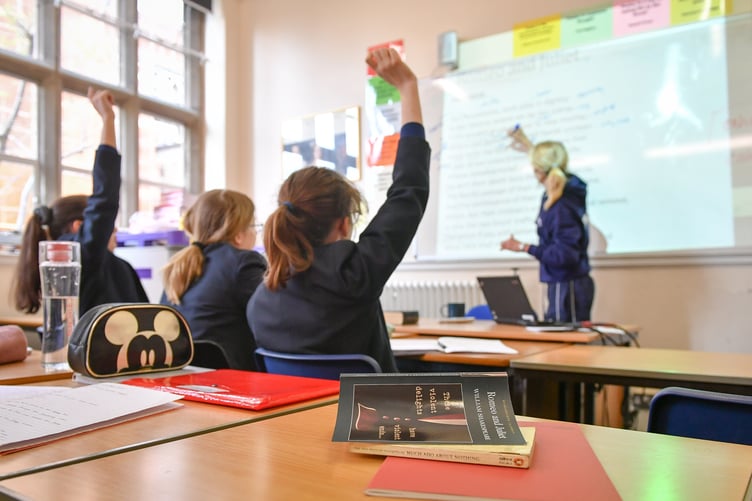Fewer teachers are working at Surrey schools, new figures show.
Despite the school workforce across the country increasing slightly, thousands of teachers have left the state school sector.
The school leaders’ union NAHT called for the next government to commit to urgent action to address the “recruitment and retention crisis facing our schools”.
Department for Education figures show there were 8,888 teachers working at the 394 state-funded schools in Surrey as of November. This was down from 8,986 the year before.
Yet across England, the school workforce has increased “marginally” by around 300 teachers to 468,700. This includes some teachers without qualified teacher status.
The figures show around 44,000 qualified teachers joined the school workforce, down 3,900 from the number of joiners the year before. Meanwhile, 43,500 qualified teachers left the state school sector.
Paul Whiteman, general secretary at NAHT, said: “These alarming figures are stark evidence of the recruitment and retention crisis facing our schools and the need for whoever forms the next government to commit to urgent action to address this.
He said there are 18,000 more pupils in schools this year, while fewer new teachers have joined compared to previous years.
He added that teacher vacancies are causing difficulties delivering the full curriculum, with subjects taught by non-specialists and supply teachers.
Teacher vacancies in state schools in England have more than doubled in the past three years, reaching an all-time high of 2,800 in November.
In Surrey schools, 61 teaching roles needed to be filled – up from 53 the year before. Of these, 59 were for classroom teachers.
There were also 47 positions that were temporarily filled.
Pepe Di’Iasio, general secretary of the Association of School and College Leaders, said: “What these figures show, and what all school and colleges leaders know only too well, is that it is becoming increasingly difficult to fill teacher vacancies.
“Often this requires advertising roles several times and making use of supply staff in the intervening period, all of which has a financial cost attached.”
He added: “Teachers are the education system’s most precious resource and the next government cannot afford to be so complacent.
“We need a comprehensive plan to address the recruitment and retention crisis and ensure schools and colleges can attract and retain the teachers they need to maintain a high standard of education for all pupils.”
Classroom teachers’ median pay in Surrey saw an increase of 7% since 2022, reaching £42,700. However, this was less than the average for England, which was £43,800.
The DfE said: “The number of teachers entering and leaving service both fell though the number of entrants continues to be higher than for leavers.
“This, combined with changes in working patterns and an increase in unqualified teachers, resulted in a marginal increase to the number of teachers in England.”
New data also shows that more than four in five children in Surrey faced long waits for special educational needs support plans last year.
Across England, the number of new education, health and care (EHC) plans rose by more than a quarter, but nearly half of all children and young people receiving one experienced prolonged waits before getting it.
The Association of School and College Leaders said failure to match the rising demand with appropriate government investment has brought the special education needs (Send) system “to the brink of collapse”.
An EHC plan is for children and young people who need more support than is available through conventional special educational needs support. EHC plans identify these needs and set out additional support required to meet them.
Department for Education figures show 2,085 children and young people aged up to 25 received an EHC plan from Surrey County Council in 2023. This was significantly up from the 1,020 plans issued the year before.
In Surrey, just 16% of all support plans were provided within the time limit.
Nationally, 84,428 new EHC plans started during last year, up by 27% from 2022. However, the figures show just 50% of them were issued within the 20-week time limit – a slight improvement from 49% in 2022.
Mr Whiteman said: “The number of children needing additional support through education and healthcare plans is now at a record high, but many families are still waiting too long for the assessments, and provision that they need.”
He added: “The current system is simply not sustainable.
“The next government must tackle the Send crisis as a priority.”
Data also show that one in seven children in Surrey are eligible for free school meals.
Across England, a record number of children were eligible to receive free school meals as of January, but education sector leaders said the numbers were just “the tip of the iceberg”, as some youngsters living in poverty are missing out on them.
Department for Education figures show there were 23,481 school children in Surrey meeting the eligibility criteria for free school meals at the start of the year, equivalent to 14.3% of all pupils in the area.
This was 766 more than in January 2023 and a record number in the past nine years.
Children in state schools in England can receive free meals if a parent or carer is receiving one of several benefits, including Jobseeker’s Allowance, child tax credits or income support.
Parents on Universal Credit can also qualify for free school meals if their household income is less than £7,400 a year.
Nationally, the benefit was available to nearly 2.1 million children, or 24.6% of all pupils – up from 23.8% in the previous year.
There were sharp differences in eligibility for free school meals across regions of the country. The highest rate was for the North East, where 31.2% of all state school pupils were eligible, while the lowest was the South East at 19.7%.
Mrl Whiteman said: “Free school meals offer a vital safety net for families and their children, and while these figures shine a light on the numbers who are struggling right now, they are sadly just the tip of the iceberg.
“The very low-income cap of £7,400 for free school meals means some children living in poverty are missing out, and it is appalling that this cap has not been increased with inflation since it was introduced six years ago.”
Sir Peter Lampl, founder of the Sutton Trust charity, said: “It’s appalling that there are record numbers of children eligible for free school meals, indicating rising poverty.”
He warned the true need for free school meals goes far beyond current eligibility criteria.
The figures also show not every child eligible for free school meals received them. In Surrey, just 73.2% of the eligible pupils were in receipt of free school meals.
Pepe Di’Iasio, general secretary of the Association of School and College Leaders, said: “The increase in the number of pupils eligible for free school meals reflects the very difficult financial situations that many families are facing.
“What’s even more concerning is we know that there are hundreds of thousands of children who are living in poverty but are not currently eligible, as well as significant numbers of pupils who are eligible but are not currently making use of the scheme.”





Comments
This article has no comments yet. Be the first to leave a comment.